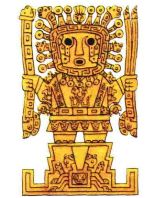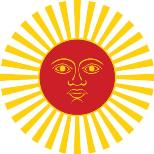Inca Empire
Mythology and Religion
History >> Aztec, Maya, and Inca for Kids
The religion of the Inca was closely tied into the everyday life of the Inca as well as with their government. They believed that their ruler, the Inca Sapa, was part god himself.
The Inca believed that their gods occupied three different realms: 1) the sky or Hanan Pacha, 2) the inner earth or Uku Pacha, and 3) the outer earth or Cay pacha.
Inca Gods and Goddesses
The religion of the Inca was closely tied into the everyday life of the Inca as well as with their government. They believed that their ruler, the Inca Sapa, was part god himself.
The Inca believed that their gods occupied three different realms: 1) the sky or Hanan Pacha, 2) the inner earth or Uku Pacha, and 3) the outer earth or Cay pacha.
Inca Gods and Goddesses
- Inti - Inti was the most important of the gods to the Inca. He was the god of the sun. The emperor, or Inca Sapa, was said to be a descendent of Inti. Inti was married to the Goddess of the Moon, Mama Quilla.
- Mama Quilla - Mama Quilla was the goddess of the Moon. She was also the goddess of marriage and the defender of women. Mama Quilla was married to Inti the god of the Sun. The Inca believed that lunar eclipses occurred when Mama Quilla was being attacked by an animal.
- Pachamama - Pachamama was the goddess of Earth or "Mother Earth". She was responsible for farming and the harvest.
- Viracocha - Viracocha was the first god who created the Earth, the sky, the other gods, and humans.
- Supay - Supay was the god of death and ruler of the Inca underworld called the Uca Pacha.

Inca god Viracocha
Inca Temples
The Inca built many beautiful temples to their gods. The most important temple was the Coricancha built in the heart of the city of Cuzco to the sun god, Inti. The walls and floors were covered with sheets of gold. There were also gold statues and a huge gold disc that represented Inti. Corichancha means "Golden Temple".
The Inca Afterlife
The Inca believed strongly in an afterlife. They took great care in embalming and mummifying the bodies of the dead before burial. They brought gifts to the dead that they thought the dead could use in the afterlife.
The Inca felt so strongly in the afterlife that when an emperor died, their body was mummified and left in their palace. They even kept some servants to watch over the dead emperor. For certain festivals, such as the Festival of the Dead, the dead emperors were paraded through the streets.

Symbol for Inti the Sun god
Inca Heavens
The Inca believed that the heavens were divided into four quarters. If a person lived a good life they lived in the part of heaven with the sun where there was plenty of food and drink. If they lived a bad life they had to live in the underworld where it was cold and they only had rocks to eat.
What were Huacas?
Huacas were sacred places or objects to the Inca. A huaca could be manmade or natural such as a rock, a statue, a cave, waterfall, mountain, or even a dead body. The Inca prayed and offered sacrifices to their huacas believing that they were inhabited by spirits that could help them. The most sacred huacas in the Inca Empire were the mummies of the dead emperors.
Interesting Facts about the Mythology and Religion of the Inca Empire
Huacas were sacred places or objects to the Inca. A huaca could be manmade or natural such as a rock, a statue, a cave, waterfall, mountain, or even a dead body. The Inca prayed and offered sacrifices to their huacas believing that they were inhabited by spirits that could help them. The most sacred huacas in the Inca Empire were the mummies of the dead emperors.
Interesting Facts about the Mythology and Religion of the Inca Empire
- They allowed the tribes they conquered to worship their own gods as long as the tribes agreed to worship the Inca gods as supreme.
- The Inca held religious festivals every month. Sometimes human sacrifice would be included as part of the ceremony.
- The Inca worshiped mountains and considered them sacred. This was because they believed the mountains were the source of water.
- The Spanish tore down the temple of Coricancha and built the Church of Santo Domingo at the same location.
- Priests were very important and powerful in Inca society. The High Priest lived in Cuzco and was often the brother of the emperor.